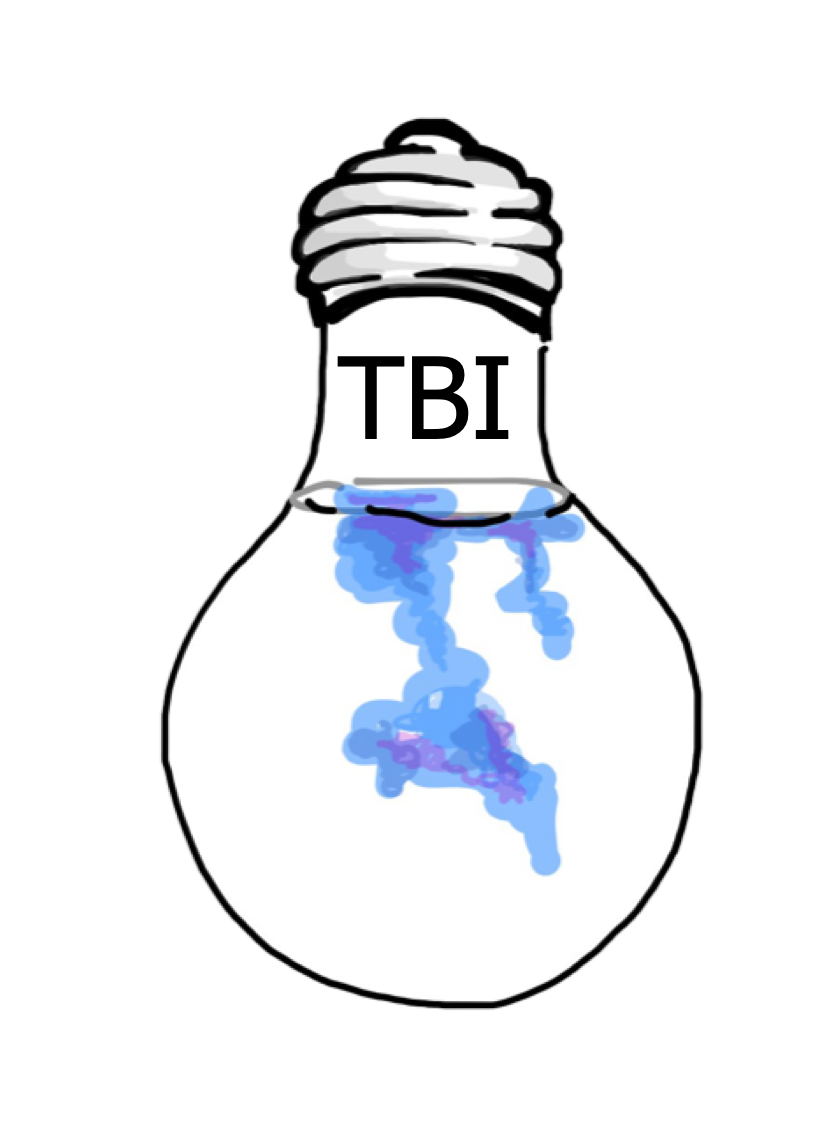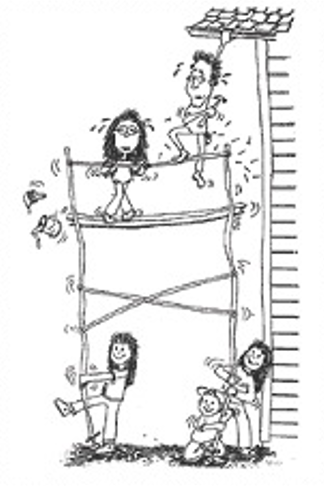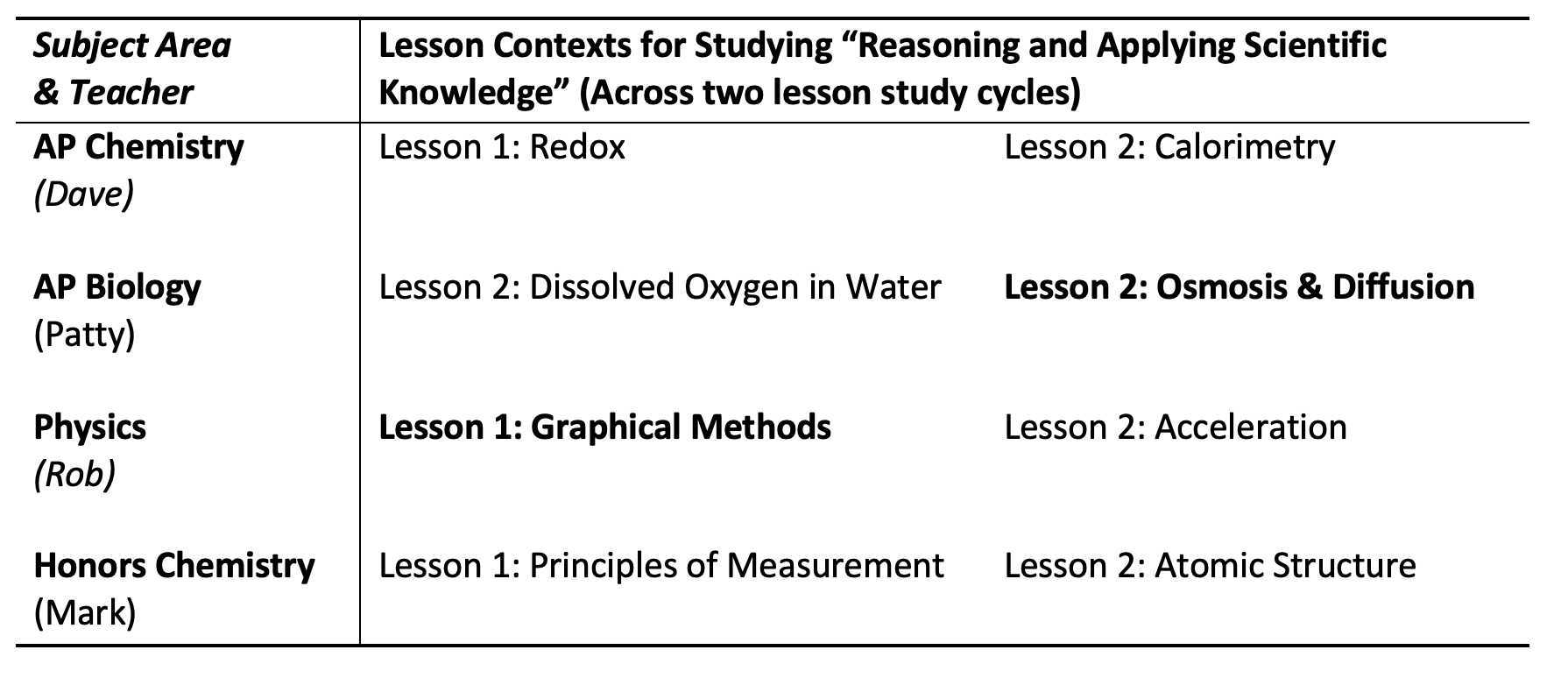Breakthrough in Productive Struggle
Carole Rast. Used by permission.
OLU Science Team: Dave Elfman, Rob LaPointe, Mark Maietta, Patty Young
At the beginning of the 2004-2005 school year, our science department met to review recent samples of student work and prioritize student learning needs across the department. Despite rigorous standards and a rigorous science curriculum we had implemented for years, the evidence showed that students continued to struggle with reasoning and applying scientific knowledge to solve novel problems. Our goal was to help students think beyond the basic facts to discover concepts about scientific phenomena, but instead we found students were mostly following “recipe labs” and regurgitating facts. Even in cases when students demonstrated some success with a certain set of procedures or ideas they could not apply or transfer those concepts on other essay prompts or lab activities with similar questions.
Shift from “Telling” to Productive Struggle
These results wouldn't change, our team realized, until we stopped relying on lectures and lab procedures that emphasized telling and memorizing. Our teaching needed to focus on building deeper understanding, and students needed more opportunities to engage in and persist with challenging tasks.
To begin this effort, we reviewed some of the literature and research on inquiry teaching and transfer. Based on this research and several ideas Mr. Lapointe shared from his physics classroom, we identified four key lesson elements we would all implement and test out during our next units of instruction. We called this list of elements the struggle/scaffold model (see list below).
Struggle/Scaffold Model: Key Elements
Engage students in a struggle activity to expose misconceptions
Withhold reference materials and suspend verbal guidance
Provide opportunities to make students’ thinking visible (e.g., presentations, concept maps)
Tailor subsequent instruction to address misconceptions and scaffold student understanding
Our central premise was that rather than having students incorporate new information with their existing cognitive structure, we need to help students break down that existing structure and re-build a solid conceptual foundation for transfer. (See video clip from our planning conversation where our team discussed why this approach was important. Note: we met in a hotel room during a fall teachers’ conference.)
With this this model as our guide, we jointly developed lessons for each of our subject areas which incorporated these basic elements. The table below provides a list of our selected lesson topics for both the first and second round of implementation.
Round One: Uneven Attempts
Our initial attempts didn't go smoothly. Instead of helping students struggle with novel problems, several members of our team unintentionally decreased lesson rigor, thereby defeating the purpose of our struggle/scaffold model.
Mr. Lapointe’s lesson was the exception. He succeeded in engaging students in a challenging struggle task where they explored the concept of graphing motion. Students worked in small groups where they analyzed a unique real-life scenario involving motion and sorted through a set of index cards to determine how they might graph that motion. The students completed their graphs on small whiteboards and explained their scenario to the class. We recorded the lesson on video and all of our team members had a chance to review the lesson prior to our debrief meeting (see lesson video).
Things went differently for the rest of the team. One example was Mrs. Young’s AP Biology lesson on dissolved oxygen in water The group designed a biology lab to help students understand how oxygen levels vary in different bodies of water (e.g., a tropical sea vs. a mountain lake) based on complex interactions of climate, salinity, water movement, and the surrounding ecosystem. The lesson opened with a review of a lab worksheet describing variables (such as climate, salinity, water movement, and organic waste) that can influence dissolved oxygen levels and showing how changes in oxygen levels affect biological activity. Next, students worked in groups to sort photos of five different bodies of water (arctic oceans, tropical seas, lakes, rivers, and swamps) and plot them on a grid according to their estimated oxygen content. Each student group then gave a presentation to explain its analysis, followed by teacher-led class discussion.
Mrs. Young expected that, when it came time to sort the photos, the groups would make their decisions based on what they had learned about climate, salinity, and other variables. Instead, students simply glanced at the photos and turned back to the worksheet to find the right answers. One group of students even lined up the worksheet next to the grid to make it easier to copy the information from one to the other. Another group seemed puzzled for a few minutes until one student exclaimed, “I have my worksheet right here!” They, too, proceeded to find the information on the sheet and transpose it to the grid. When asked to present their grids to the class, most of the groups gave more or less identical presentations: They pointed (correctly) to where the photos were supposed to go on the grid, but they offered little or no explanation as to their reasoning.
A few days later, as part of our reflection and debrief meeting, we took some time to study student works samples and discuss our first round of teaching efforts. We also studied selected video clips from Mr. Lapointe’s lesson. While analyzing these results and reflecting on key findings, our group came to the clear realization that most of our students (with the exception of the physics lesson) were not engaged in a meaningful struggle with scientific concepts. Mrs. Young explained that she had been somewhat fearful of leaving students without any guiding framework or assistance with the struggle task, “I think it was fear…I was afraid to let the students struggle, afraid of the frustration they would express.” Here is a short video clip from that debrief meeting and Mrs. Young’s moment of insight.
Round Two: A Breakthrough in Productive Struggle
The second round of lessons led to some dramatic changes in each of our classrooms. We all made a second attempt with the struggle/scaffold model and designed a discovery lab for each subject area. All four teachers made a conscious effort to facilitate productive struggle and avoided giving away hints or providing resources that might prevent opportunities for reasoning and problem-solving.
After this second round of teaching, we watched several video clips from Mrs. Young’s lesson on osmosis and diffusion. Unlike round one, Mrs. Young’s students had no prior knowledge about the lab and no reference materials to rely on. There was significant distress in many groups as they struggled to understand the concepts without any assistance from other resources. Mrs. Young circulated to clarify instructions and encourage further inquiry, but completely suspended verbal guidance, even as students playfully accused her of trying to “lower their grades.” Her response was, “You just have to learn to live with a little dissonance. It’s going to be okay.” Rather than giving answers, she asked probing questions like, “Do you think the molarity of the bag might change as it’s soaking in the sugar water?” or “Why are you measuring the cups?” When a student asked if they were “on the right track,” she smiled and responded with, “It’s the joy of discovery, don’t you think?...Have you set up a data table to collect your data?”
Mrs. Young also intentionally carried a notepad to record notes as she circulated between groups. Rather than prematurely interject remarks and provide too much guidance or information, she wrote down various observations, such as misconceptions that individual students had or common patterns of difficulty to address in future instruction. At times, she would look down and pretend to record comments, even though she was intently listening to what students were saying, to encourage them to rely more on their own collective reasoning. In this way, she learned how to foster rigorous levels of inquiry, requiring students to persist with challenging concepts and identify gaps in understanding. The insights she gained enabled her to more effectively address these gaps during post-lab discussion and presentations.
During our second debrief and reflection meeting we documented several key findings about the value of inquiry--both for the students and for the teachers.
A new level of inquiry for students
The results we reviewed from student work as well as informal student interviews showed evidence of progress. Mrs. Young shared convincing evidence from the transfer prompt she had assigned, explaining that within one class of AP Biology students, there were 10 different approaches to the same transfer question, and all but one student demonstrated an advanced conceptual understanding of osmosis and diffusion. Mr. Lapointe reported progress on pre-post assessments in physics where students showed improved scientific reasoning. Other members shared evidence from informal interviews with students who indicated that they “learned things better this way,” “had a better understanding,” or “enjoyed having the chance to solve problems.”
As we synthesized evidence and recorded successes and failures of the struggle/scaffold efforts, all members indicated they were looking forward to further refining this approach and hoped to continue the inquiry work. Mr. Maietta suggested it might be interesting to strategically schedule struggle/scaffold lessons at critical points in the curriculum. Mr. Elfman talked about designing similar lessons in the future and watching for improvements in students’ approach to planning scientific procedures. Mr. Lapointe suggested the possibility of including a journaling component during the struggle stage to help students reflect more meaningfully on their own thought processes. Mrs. Young proposed a related idea of creating assignments where students are graded for the process and not for their results.
A new level of inquiry for teachers
In addition to observations of student growth in inquiry, the team discussed how the lesson study process had enlightened our understanding of the teacher role in facilitating learning of science. We learned to better differentiate productive struggle from failure and to tailor instructional moves accordingly. We began to recognize how such teacher decisions as the materials we chose to provide or the comments we might interject during lab activities can significantly influence the depth of student learning. We started teaching the importance of error analysis by allowing students to experience the consequences of imprecise measurement procedures. We learned to monitor group projects more purposefully, making sure the struggle resulted from challenging problem-solving tasks, not from confusion with instructions, frustration with group dynamics, or lack of teacher support. And we patiently helped students discover the satisfaction that comes from persisting with a difficult task.
Postscript Update
Six months later, after a sustained effort to incorporate these new teaching practices, Mrs. Young sent out an email to share some positive assessment results which she described as “higher than any class ever before.” She went on to explain, “I am so happy for my students, I just sat down, closed the door of my office and cried and cried and gave thanks. I have to believe I changed the way I taught, that making them struggle really bridged the gap. This was my most enjoyable year of teaching in my 28 years…” --Patty


